You can listen to or watch this article here:
As the Ethereum Classic (ETC) ecosystem grows, it is difficult to find terms to refer or describe it. The typical ways people find to talk about it is by calling it a “community”, “friends”, or even “family”.
Of course all these are not only attempts to describe it functionally, but also a sort of “terms of endearment” and true passion, as it requires a lot of work, energy, time, and treasure to maintain and communicate about such a valuable network that has gone through so many trials and tribulations since its inception.
This is because ETC is not only the original, immutable, highly secure proof of work based blockchain effectively abandoned by the Ethereum ecosystem when they decided to bail out a few friends and investors in 2016, but has been the target of constant attacks by opportunistic elite ‘academics’ and ‘scientists’, has gone through developer crises, and has been the target of a 51% attack.
However, and evidently, the fact that Ethereum Classic is growing and increasing its share in the crypto industry, which is consistent with a path to a dominant position at the base layer in the long term, is yet more confirmation that antifragile systems actually do become stronger, persistent, useful, and more secure the more they experience stress and hardship, either technical or social.
The Ecosystem
After the extended, general bear market and recession in the blockchain industry since the end of 2017, Ethereum Classic is showing frank signs of growth and strength.

The “ecosystem” may be described as a global network of nodes, miners, developers, sponsors, investors, and volunteer participants.
Nodes
During the lower points of the 2018 bear market, ETC had around 120+ nodes in the network. During 2019, the count was regularly stable at 300+ nodes globally. By the beginning of 2020, that count has peaked at 800+ and now it is holding stable at around 600+ nodes spread across many regions.
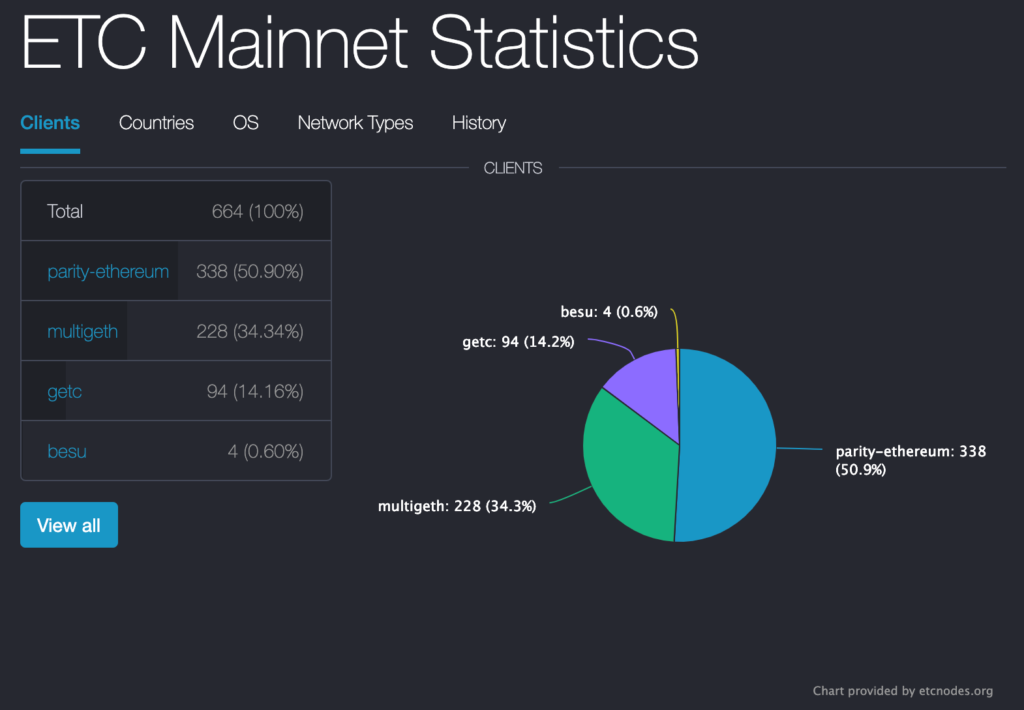

Miners
During 2018 and 2019, the hash rate, as measured in tera hashes per second (THs), of the ETC network typically hovered between 6 THs and 12 THs. Since the beginning of 2020, presumably due to ETC’s price recovery, it has reached new historic highs at around ~19Ths.

It is important to note, that the term “miners” means hundreds, if not thousands, of mining gear owners all over the world, who group in mining pools to increase their chances of earning block rewards, across several compatible networks, and smooth their income stream. Although miners may rotate from network to network, their interest, evidently, has increased in pointing their computing power to ETC.
The mining pool companies themselves are much more stable players in the ETC ecosystem as their shares and participations have been quite stable since ETC’s origin. Among these participants are global brands such as Ethermine, Nanopool, MiningPoolHub, and 2miners, who consistently produce blocks for the chain.
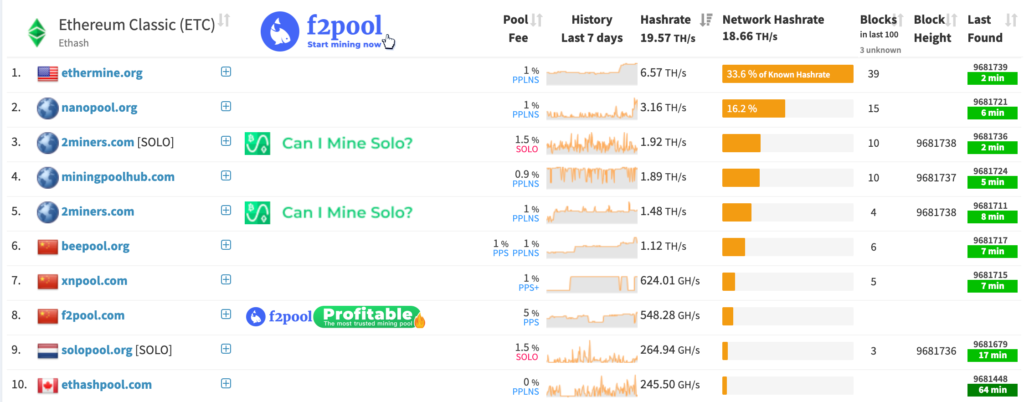
Developers
Right after the Ethereum ecosystem decided to fork from the mainnet, ETC was maintained by very few developers. By 2018 that number had grown to more than 12 developers from the pioneering company, led by Igor Artamonov, called ETCDEV.
By early 2020, there are several companies and volunteers maintaining a diverse set of node clients, including Parity-Ethereum (Parity Technologies), Multi-Geth original (Wei Tang), Multi-Geth fork (ETC Core), and Hyperledger Besu (Chainsafe).
It is difficult now to count what specific number of developers are working on base layer clients and extra infrastructure and applications on top, but a typical, albeit not perfect, observation for at least protocol development engagement is the Ethereum Classic Improvement Proposal (ECIP) process Github repository, where the main source of ideas and improvements originate, are posted, and debated. The activity and diversity of proposals in ETC has increased significantly since 2018.
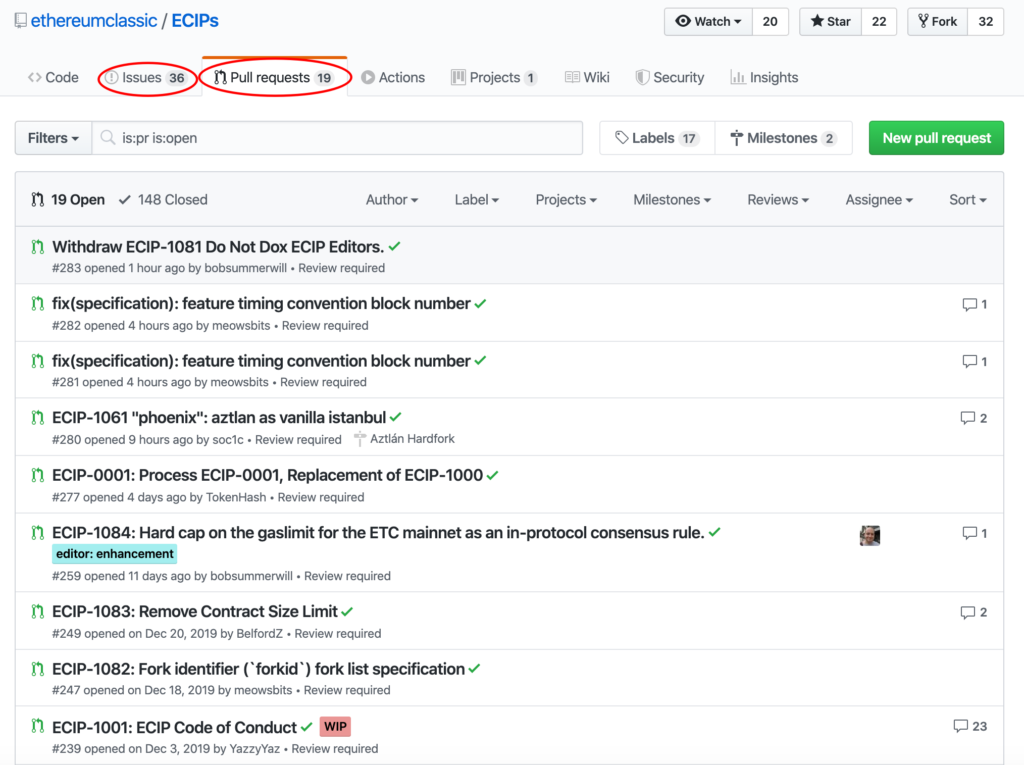
It is worth noting that in the “extra infrastructure and applications on top” mentioned above, there are many teams working, and their activity and participation is often communicated in the press and on social media.
Sponsors
“Sponsors” is not usually a category used to describe a type of participant in a blockchain network, but these entities and persons could be regarded as volunteers that actually spend hard money in the ecosystem.
ETC has extremely attractive fundamentals, so this has attracted, since the beginning, some savvy companies to spend money in its development with the expectation of a financial return either through future business or $ETC token appreciation.
These entities are extremely important as they pay for critical parts of the protocol, infrastructure, and application development. They do this with a future expectation, which has normal inherent risk and uncertainty.
The above constitutes a true skin in the game. Some of these entities are Grayscale, thru its ETC Trust product and funding of the ETC Cooperative, who in turn funds Chainsafe; DFG through its funding of ETC Labs (L2 apps and infrastructure) and ETC Core (protocol development); IOHK through its funding of community development, marketing, and client (Mantis) development; and Parity Technologies through client (Parity-Ethereum) development.
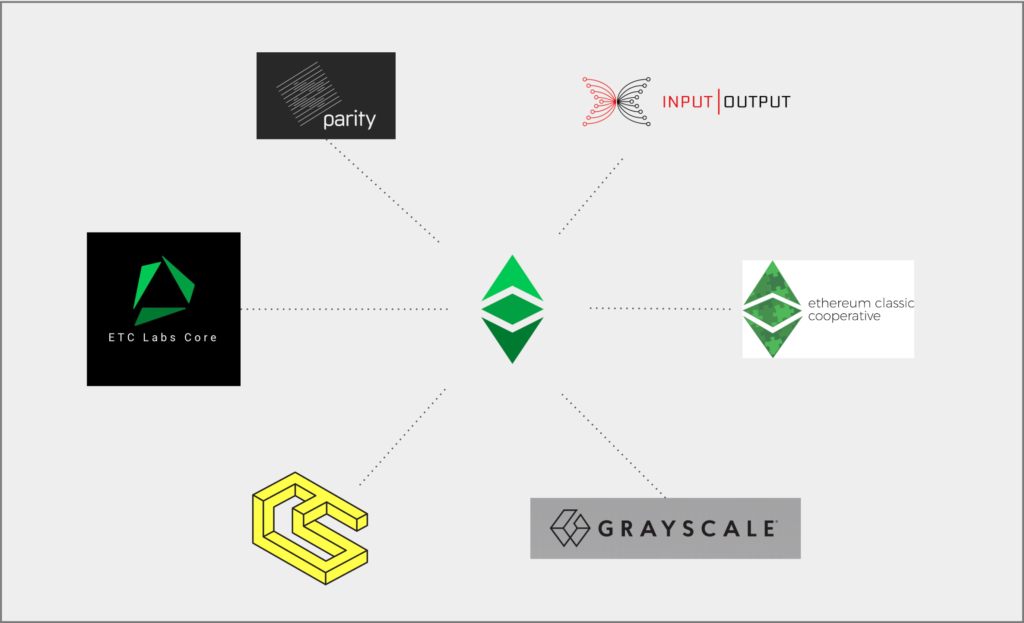
Investors
It has to be stressed here that blockchain technology and networks have a set of economic and financial incentives which are a central part of their security model.
Potential demand for decentralized computing drives the value of the underlying $ETC token, which incentivizes miners to increase mining hash rate. Growth in hash rate makes the network more secure, and more security motivates investors to buy more cryptocurrency.
The same dynamics occur on the developer side: As decentralized computing becomes more popular, more developers participate in the network. More developers make the network more attractive, so more miners and full node operators join the system globally. This makes it more secure, therefore increasing the demand for decentralized computing, thus capital and portfolio investing.
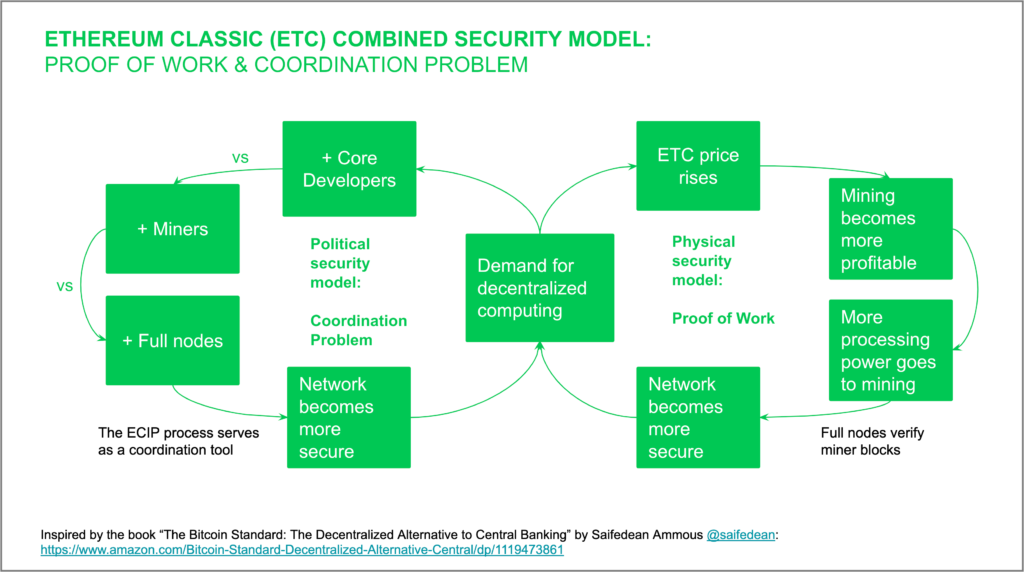
Investors in particular are a critical link in this model. They provide liquidity for miners and raise the value of the token, by risking capital, so the other participants may both be economically incentivized and track a clear metric for their work and effort.
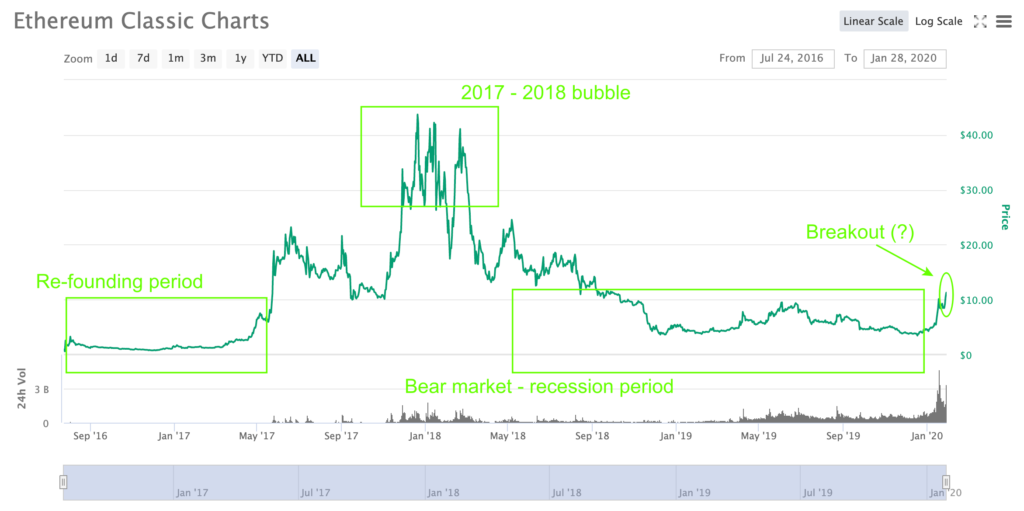
Volunteer Participants
If the base design of ETC is an economic system with financial incentives, how can there be so may volunteers working on it?
The answer to the above very legitimate question is to differentiate between “economic” and “financial” incentives. Financial incentives are direct and very obvious for some participants such as node operators and, especially, investors and miners.
However, economic incentives, that are not direct financial incentives, can also be identified for other participants as developer, communication, social, and marketing volunteers.

For example, in the case of this volunteer author, the economic incentives for maintaining the Etherplan blog, doing research, and writing about ETC are for the utility of gaining experience and deeper knowledge, gaining exposure in the industry, and eventually converting those investments in time and effort into a financial income sometime in the future, where, most importantly, part of that income will be saved in $ETC due to its significant potential.
The utility that other volunteers may expect or gain by participating in the ETC ecosystem is very difficult to guess on a case by case basis, and some may indeed do it for the sheer selfless advocacy (which nevertheless has some sort of personal utility), but it wouldn’t be a long shot to say that, mostly, they must be similar in primary, secondary, and tertiary potential benefits as the ones described by this author.
Why “Ecosystem” and not “Community”, “Friends”, or “Family”?
Ethereum Classic is, at its core, a system for hosting money, property, and agreements without the need of using trusted third parties. The main reason to prescind of trusted third parties is to minimize the risks that they present to the integrity of such money, property, and agreements. One of those risks is the restriction of social scalability.
Social scalability is the exchange of the efficiency of centralized services for the open and unrestricted participation in decentralized, but computationally inefficient, systems by anyone in the world, regardless of their country, culture, legal jurisdiction, ideology, beliefs, gender, race, or any other human condition.
With this in mind, it should be clear that “communities”, “friends”, and “family” must be reduced groups of individuals who know each other, and may easily track each other’s behavior, and thus reciprocal altruism.
Evidently, these kinds of groups would not be able to manage and regulate large global networks of nodes, miners, developers, sponsors, investors, and volunteer participants.
The pretension that such small, limited, and human-brain-dependent associations can foster and administer a global permissionless network is, at minimum, a naive thought. Not only that, but, from a communications, signaling, and marketing perspective, the “community”, “friends”, and “family” rhetoric actually gives the impression of exclusivity and small scale, which may tend to deter new participants, rather than promote their free access.
The biological analogy of “ecosystem” seems to be a better way of describing Ethereum Classic, even if it includes a concept of “community” of diverse organisms. This is because ecosystems may be, in fact, diverse, cooperative, adversarial, pan-regional, based on tradeoffs and payoffs, and may include new, evolving, or exiting organisms and species.
Conclusion
There is no doubt that, for many reasons, to work on Ethereum Classic in any of the capacities mentioned in this article requires a high level of commitment, work ethic, physical and emotional stamina, and the very real cost of time and money.
However, given the extraordinary diversity and inclusiveness required across all jurisdictions, regardless of current politics and social strife in space and time, it is important to bear in mind what are the principles that will sustain that permissionlessness continuously.
Because of the excellent work, however chaotic and stressful at times, of all participants, ETC seems to be in a sound path of growth, regardless of short term fluctuations, and is well positioned to become critical infrastructure in the future, which may very well result in significant economic and financial gains.
Such potential can only be finally achieved if all participants have not only the correct attitude and predisposition, but also the right mindset.
Code Is Law